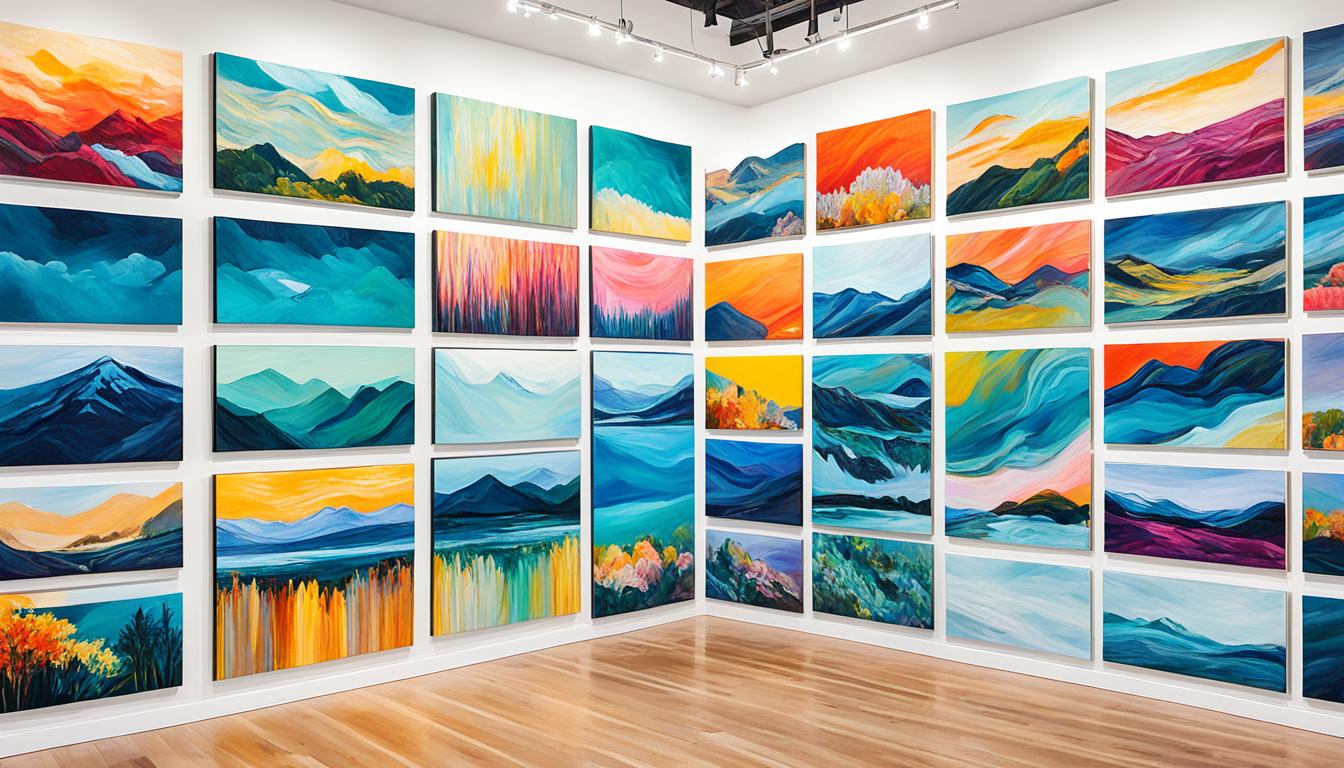This post contains affiliate links.
Have you ever stood in front of a breathtaking piece of artwork, mesmerized by the colors, the brushstrokes, and the emotions it evokes? Art has a unique power to connect with us on a profound level, stirring our senses and touching our souls. And if you are an artist, there is nothing more fulfilling than sharing your creative expression with the world.
But here’s the thing – creating art is just one part of the journey. As an artist, you also need to find a way to showcase and sell your acrylic artwork online. It’s about more than just putting a price tag on your creations – it’s about connecting with people who resonate with your art, who want to bring a piece of your vision into their own lives.
That’s where the magic happens – when your art finds its way into someone’s heart and home, becoming a part of their story. Selling and promoting your acrylic artwork online opens doors to a vast marketplace, where you can reach art lovers from all corners of the world. It’s a chance to share your passion, make a living doing what you love, and create a lasting impact through your art.
In this article, we’ll dive into the world of selling acrylic artwork online. We’ll explore art marketing strategies, provide tips on selling art online, and share ideas for promoting your artwork to attract the right audience. So, grab your paintbrushes and let’s embark on this creative journey together!
Key Takeaways:
- The digital age provides numerous opportunities for artists to sell their acrylic artwork online.
- Decide what type of art to sell and how to sell it – whether it’s original artwork, prints and copies, or artwork from other artists.
- Register your business properly as a sole proprietorship or LLC and consider obtaining a business license and an employer identification number (EIN).
- Choose from a variety of sales channels, including online platforms like Etsy, Amazon, and social media platforms like Instagram.
- Determine pricing based on factors such as the time and effort invested and consider special offers and limited runs to incentivize sales.
Deciding What Art to Sell and How to Sell It
So you’ve decided to enter the world of online art sales. Now comes the exciting part – deciding what type of art you want to sell and how you want to sell it. This is where your artistic vision and entrepreneurial mindset come together to create a successful online art business.
One option is to sell your own original artwork. This allows you to set higher price points and attract buyers who are looking for unique, one-of-a-kind pieces. Selling original artwork not only showcases your artistic talent but also creates value for collectors and art enthusiasts.
If you want to cater to a wider audience, you can also consider selling copies and prints of your work. This provides a more affordable option for buyers who may not be able to invest in original artwork but still want to enjoy your artistic style. Prints and copies allow you to reach a larger market and increase your art sales.
Another interesting approach is to sell the artwork of other artists. Curating a collection of artwork from different artists adds variety and depth to your online store. By showcasing the work of other talented artists, you can create a unique platform and attract a diverse customer base.
To maximize your reach and sales potential, it’s essential to establish an online presence. Creating your own website or utilizing popular e-commerce platforms like Etsy and Amazon allows you to showcase your art to a wide audience. These platforms offer user-friendly interfaces, secure payment processing, and built-in marketing tools to help you grow your online art business.
Remember, selling art online is not just about the artwork itself; it’s also about creating a captivating online store that reflects your artistic style. Consider investing in professional photography to showcase your artwork in its best light. Craft compelling product descriptions that convey the story and inspiration behind each piece. And don’t forget to optimize your online store for search engines to increase your visibility and attract potential buyers.
Pros and Cons of Different Art Selling Options
| Selling Option | Pros | Cons |
|---|---|---|
| Selling Original Artwork | Allows for higher price points Appeals to buyers seeking unique pieces | Requires more time and effort Limited availability |
| Selling Copies and Prints | More affordable option for buyers Reaches a larger market | May devalue the original artwork Requires consistent printing and shipping |
| Selling Other Artists’ Work | Curate a diverse collection Attracts a broader customer base | Requires building relationships with other artists Profit sharing with artists |
Whether you choose to sell your own original artwork, prints and copies, or the artwork of other artists, the key is to stay true to your artistic vision and connect with your target audience. With the right approach and online sales channels, you can turn your passion for art into a thriving online art business.
Registering Your Business
Now that you’re ready to sell your artwork online, it’s time to ensure your business is officially registered. Registering your business provides legitimacy and allows you to access additional benefits and opportunities. Let’s explore the steps to register your business and ensure you’re on the right track.
Choosing the Right Business Structure
Before registering, consider the business structure that best suits your needs. You have two main options:
- Sole Proprietorship: This is the simplest and most common business structure for artists. It’s free to register, and as the sole owner, you have full control over your business decisions. However, keep in mind that personal and business finances are not separate, and you are personally liable for any business debts or legal issues.
- LLC (Limited Liability Company): Although it involves more paperwork and fees, opting for an LLC can provide additional protection for your personal assets. By forming an LLC, you create a legal separation between your business and personal finances. It also offers benefits such as easier expense tracking and the ability to hire employees in the future.
Obtaining a Business License and EIN
Depending on your location and the type of artwork you sell, you may need to obtain a business license. Check with your local government or Small Business Administration for specific requirements in your area.
Additionally, acquiring an Employer Identification Number (EIN) is recommended, especially if you plan to open a business bank account. An EIN is a unique tax identification number assigned by the IRS to businesses for tax filing and reporting purposes.
Setting Up a Business Bank Account
Separating your personal and business finances is crucial when running a business. Opening a dedicated business bank account not only helps you manage your finances effectively but also adds a layer of professionalism. It makes it easier to track income and expenses and simplifies the tax filing process.
Ensure you have your business registration documents, EIN, and personal identification ready when visiting the bank to open your business account.

Registered businesses enjoy various benefits, from legal protection to financial organization. Take the necessary steps to register your business properly and set yourself up for success.
Choosing Your Sales Channels
When it comes to selling your artwork online, the world is your canvas, and you have the power to choose the right sales channels to showcase your talent and connect with your audience.
With a diverse range of options available, it’s essential to explore various sales channels to maximize your reach and increase your sales potential. Let’s dive into some of the top platforms and channels that can help you establish a strong online presence and boost your art sales.
E-commerce Platforms:
When it comes to selling artwork online, e-commerce platforms are a game-changer. They provide you with ready-made online stores and access to a large customer base. Some popular platforms for artists include:
- Fineartamerica: A platform dedicated to showcasing and selling artwork.
- Society6: An online marketplace featuring artist-designed products.
- Etsy: A marketplace for handmade and vintage items.
- Amazon, Zazzle, and Redbubble: Popular platforms that offer a wide range of customizable products.
- Creative Market: A platform for selling digital products like fonts, graphics, and templates.
Social Media:
Social media is not just for sharing memes and cute animal videos; it’s a powerful tool for artists to promote their work and attract a large audience. Platforms like Facebook and Instagram allow you to showcase your portfolio, engage with potential buyers, and build a loyal following. Utilize these platforms to create a buzz around your art and drive traffic to your online store.
Fiverr:
Are you interested in taking commissions or providing custom artwork? Fiverr is a popular freelance platform that connects artists with clients looking for personalized art services. You can offer various art-related gigs, such as custom illustrations, portrait paintings, or digital artwork, and set your own prices.
Getty Images:
If you want to sell your artwork as stock images or license it for commercial use, Getty Images is your go-to platform. By submitting your artwork to Getty Images, you can potentially earn royalties whenever your artwork is used in advertisements, publications, or digital media.
Remember, the key to success in selling your artwork online is to diversify your sales channels. By utilizing multiple platforms and social media channels, you can expand your audience, increase your visibility, and generate more sales. Take the plunge and explore these sales channels today!
| E-commerce Platforms | Social Media | Fiverr | Getty Images |
|---|---|---|---|
| Fineartamerica | Fiverr | Getty Images | |
| Society6 | |||
| Etsy | |||
| Amazon | |||
| Zazzle | |||
| Redbubble | |||
| Creative Market |
Determining Pricing
Pricing your artwork is a crucial step in the online selling process. While it can be challenging, finding the right balance will help you attract buyers and maximize your earnings. Here are some key factors to consider when determining pricing for your artwork:
Pricing Originals
Your original artwork represents your unique style and creative vision, making it highly valuable. When pricing originals, consider the time, effort, and skill invested in creating each piece. Think about the emotional and artistic value it holds for both you and potential buyers.
Pro Tip: Remember, your originals are one-of-a-kind, so don’t undervalue your work. Price it accordingly to reflect its worth.
Pricing Prints and Copies
Prints and copies of your artwork offer a more affordable option for buyers while still allowing them to enjoy your work. When pricing prints, consider the production costs, the quality of materials, and any limited edition aspects. Keep in mind that the pricing for prints is generally lower than that of originals.
Pro Tip: Set competitive prices for your prints and copies to make them attractive to a broader audience while still maintaining profitability.
Pricing Merchandise
Expanding your art onto merchandise like t-shirts, mugs, or tote bags can be an excellent way to diversify your product offerings. When pricing merchandise, consider the production costs, the market demand for your artwork, and any artist royalties. Additionally, research the pricing strategies used by similar artists to ensure competitive pricing.
Pro Tip: Take into account the perceived value of your artwork on merchandise and set prices that align with market trends and customer expectations.
Special Offers and Limited Runs
Creating a sense of exclusivity can be a powerful way to drive sales and increase demand for your artwork. Consider implementing special offers, such as discounts or bundle deals, to incentivize buyers. Limited runs, where you produce a set number of prints or copies, can also create a sense of urgency and exclusivity.
Pro Tip: Experiment with different special offers and limited runs to gauge their impact on your sales and customer engagement.
Remember, pricing your artwork is not set in stone. It’s okay to adjust your prices as you gain experience, popularity, and demand. Keep track of your sales data, customer feedback, and market trends to make informed pricing decisions that align with your goals.

| Artwork Type | Considerations |
|---|---|
| Originals | Time, effort, skill, emotional value |
| Prints and Copies | Production costs, limited edition aspects |
| Merchandise | Production costs, market demand, artist royalties |
| Special Offers and Limited Runs | Discounts, bundle deals, exclusivity |
Marketing Your Online Art Store
So, you’ve set up your online art store, but how do you get the word out and attract potential buyers? Marketing is the key to success in the digital marketplace. By following these strategies, you can effectively promote your art and increase your online sales.
Search Engine Optimization (SEO)
Optimizing your website for search engines is crucial for driving organic traffic to your art store. Pay attention to keywords relevant to your artwork and incorporate them into your website’s content, titles, and descriptions. This will help search engines recognize your store as relevant and boost your visibility.
Promoting Listings
Promoting your art listings is essential to stand out from the competition. Consider using pay-per-click (PPC) ads to target specific keywords and increase your visibility on search engines and social media platforms. These targeted ads can help drive quality traffic to your art store.
Social Media
Don’t underestimate the power of social media in promoting your art. Social platforms such as Facebook, Instagram, and Pinterest allow you to showcase your artwork, engage with potential buyers, and build a loyal following. Share behind-the-scenes glimpses of your artistic process, highlight new pieces, and interact with your followers to create a strong online presence.
Content Marketing
Create compelling content related to your artwork to engage with potential buyers and boost your SEO efforts. Write blog posts, create videos, or host podcasts that provide insight into your artistic process, share tips, or discuss relevant art techniques. By offering valuable content, you establish yourself as an authority and attract a wider audience.
Collaborating with Other Artists
Collaborating with other artists is a fantastic way to expand your reach and tap into new networks. Consider partnering with other artists for joint exhibitions, group projects, or even social media takeovers. By cross-promoting each other’s work, you can expose your artwork to a larger audience and gain valuable networking opportunities.
Collaboration with other artists can be like a beautiful masterpiece—where creativity blends, colors harmonize, and the results exceed expectations.
Now that you have an idea of how to market your online art store, it’s time to put these strategies into action. Remember, consistency is key. Stay active on social media, continuously update your website, and explore new marketing avenues to keep your art store thriving.
Selling Art Offline
While online sales are important for reaching a global audience, don’t forget about the exciting opportunities that await you in the world of offline art sales. Participating in local exhibitions, artisan markets, and pop-up art spaces allows you to connect directly with potential buyers and showcase your artwork in person. These offline events provide a more personal touch, giving art enthusiasts the chance to experience your creations up close and fostering a deeper connection.
Making a Lasting Impression at Local Exhibitions
Local exhibitions are a fantastic way to showcase your artwork and interact with art enthusiasts in your community. These events often attract a diverse crowd, including collectors, gallery owners, and fellow artists. Take advantage of the opportunity to make a lasting impression by creating a visually stunning booth or display that reflects your artistic style. Engage with visitors, share the stories behind your artwork, and be prepared to answer any questions they may have. Don’t forget to bring business cards or promotional materials to ensure you stay on their radar even after the exhibition.
Thriving in Artisan Markets
Artisan markets are bustling hubs of creativity, bringing together artists from various disciplines to showcase and sell their unique creations. These markets offer a vibrant atmosphere that attracts both locals and tourists seeking one-of-a-kind, handcrafted pieces. Stand out in the crowd by curating an eye-catching display that highlights your artwork’s distinctive features. Consider offering live demonstrations or workshops to engage with visitors and showcase your artistic process. Don’t forget to have a range of price points, from affordable smaller pieces to larger investment-worthy artworks.
Embracing the Pop-Up Art Space Trend
Pop-up art spaces have gained popularity in recent years as temporary venues that exhibit and sell art. These spaces can be anything from vacant storefronts to repurposed buildings and public spaces. The unique nature of pop-ups attracts curious art enthusiasts who are eager to explore new and unconventional art experiences. Take advantage of this trend by collaborating with other artists to transform a space into a collective gallery. Curate a compelling exhibition theme, promote it through social media and local networks, and host special events like artist talks or guided tours to draw visitors.
Offline art sales offer an opportunity to connect with buyers on a personal level, allowing them to appreciate your artwork in a tangible way. By participating in local exhibitions, artisan markets, and pop-up art spaces, you can create memorable experiences, build a local following, and gain valuable feedback to refine your artistic practice. So, step out from behind the screen and let your art shine in the offline world.
Selling art offline doesn’t mean neglecting your online presence. Use these offline experiences to build connections and direct traffic to your online art store, where potential buyers can continue to explore and purchase your artwork.

| Art Sales Channel | Advantages | Considerations |
|---|---|---|
| Local Exhibitions | – Direct interaction with buyers – Opportunity for networking – Exposure to collectors and gallery owners | – Cost of participation – Limited duration of exhibition – Local audience reach |
| Artisan Markets | – High foot traffic – Lively and creative atmosphere – Access to local and tourist buyers | – Competition with other artists – Weather considerations for outdoor markets – Setting up and managing a booth |
| Pop-Up Art Spaces | – Trendy and unique art experiences – Collaboration opportunities with other artists – Potential media coverage | – Finding suitable spaces – Limited duration of exhibitions – Securing necessary permits and permissions |
Consider incorporating offline art sales into your overall art marketing strategy. By combining online and offline efforts, you can reach a wider audience, foster meaningful connections, and create a well-rounded presence in the art world.
Working with Galleries
Collaborating with galleries can open new doors for artists, providing avenues to expand their reach and gain valuable exposure. When partnering with galleries, artists have the opportunity to be represented by professionals who understand the art industry and can effectively promote their work. Galleries serve as platforms for artists to exhibit their artwork, allowing potential buyers to view and appreciate their creations in physical or online spaces.
Furthermore, working with galleries can lead to exciting licensing opportunities, enabling artists to extend their brand and income potential. By licensing their art, artists can grant permission for their work to be reproduced on various merchandise, such as prints, mugs, or clothing, allowing them to reach a broader audience and increase their revenue streams.
So, if you’re an artist looking to make a mark in the art world, consider partnering with galleries to showcase your artwork, broaden your horizons, and explore lucrative licensing opportunities.
“Working with galleries not only provides exposure, but it also offers artists the validation, support, and representation they need to succeed in the competitive art industry.” – Emma Davis, Professional Artist
Benefits of Working with Galleries
Galleries offer numerous benefits to artists, including:
- Professional representation:
will represent you and your artwork, advocating on your behalf and connecting you with potential buyers.
Choosing the Right Gallery
When considering gallery partnerships, it’s crucial to choose the right fit for your artistic style and goals. Research and evaluate galleries based on factors such as:
- Artistic compatibility: Ensure that the gallery appreciates and showcases artwork similar to your style, enhancing the chances of successful representation.
- Reputation and track record: Investigate the gallery’s reputation within the art community, looking for a proven track record of successful artist representation and sales.
- Exhibition opportunities: Assess the frequency and quality of exhibitions organized by the gallery, considering the potential for exposure and reaching the right audience.
- Licensing agreements: Inquire about the gallery’s licensing agreements, understanding the terms and benefits they offer to artists.
- Communication and support: Evaluate the gallery’s level of communication, responsiveness, and ongoing support for represented artists.
Remember, finding the right gallery partnership can significantly impact your artistic career, so take the time to thoroughly research and select the gallery that aligns with your artistic vision and aspirations.
Artist Spotlight: Jillian Barnes

Jillian Barnes, a renowned contemporary artist, has elevated her career through strategic collaborations with galleries. Her artwork reflects vibrant abstract expressionism and has garnered attention from art enthusiasts globally. After partnering with esteemed galleries like
and
, Jillian’s work was exhibited in prestigious art shows, attracting influencers and collectors alike.
In addition to showcasing her artwork, Jillian’s collaboration with galleries has paved the way for licensing opportunities. Her unique style and captivating compositions have been featured on prints, home decor items, and even fashion accessories, generating supplemental income and extending her artistic brand.
When asked about the impact of working with galleries, Jillian expresses her gratitude:
“Collaborating with galleries has been a game-changer for me. Their expertise and dedication to promoting my artwork have opened doors I never thought possible. Through exhibitions and licensing agreements, my art has reached a broader audience, allowing me to connect with art lovers and expand my creative horizons.” – Jillian Barnes, Contemporary Artist
Comparison of Selected Galleries
| Name | Artistic Focus | Reputation | Exhibition Opportunities | Licensing Agreements |
|---|---|---|---|---|
| [Gallery name 1] | Abstract and Contemporary | Highly regarded in the art community | Regular exhibitions and collaborations with renowned artists | Offers diverse licensing options |
| [Gallery name 2] | Realism and Figurative | Known for promoting emerging artists | Great platform for artists to debut their work | Collaborates with artists on unique licensing projects |
| [Gallery name 3] | Mixed Media and Sculpture | Recognized for innovation in contemporary art | Hosts prestigious international exhibitions | Offers exclusive licensing opportunities for artists |
Conclusion
Selling and promoting your acrylic artwork online opens up a world of opportunities for artists to unleash their creativity and generate income. By carefully considering what type of art to sell, registering your business, selecting the right sales channels, determining pricing, and implementing effective marketing strategies, you can successfully showcase and sell your artwork to a global audience.
While online sales are crucial in today’s digital marketplace, don’t overlook the power of offline opportunities. Engaging in local exhibitions, participating in artisan markets, and setting up pop-up art spaces allow you to connect with customers on a personal level and showcase your creations in person, fostering a deeper connection.
Collaborating with galleries can also be a game-changer for expanding your reach and gaining exposure. Building relationships with gallery owners can lead to representation, exhibitions of your artwork, and even licensing opportunities. By diversifying your sales channels and embracing the art world both online and offline, you can thrive in this ever-evolving industry.
In conclusion, selling your acrylic artwork online provides a platform for you to express your artistic vision and share it with the world while also earning a living. With careful planning, strategic decision-making, and a passion for your craft, you can make your mark in the digital marketplace and beyond. So harness your creativity, seize the opportunities available, and let your art shine.
FAQ
How can I decide what type of acrylic art to sell and how to sell it?
You can choose to sell your own original artwork, copies and prints of your work, or even showcase the artwork of other artists on your online store.
What do I need to do to register my art business?
You can register your business as a sole proprietorship for free, but it is recommended to consider registering as an LLC for extra benefits. You may also need to obtain a business license and an employer identification number (EIN) to set up a business bank account.
What are some popular sales channels for selling acrylic artwork online?
There are numerous platforms and channels available, including creating your own online store, using platforms like Fineartamerica, Society6, Etsy, Amazon, Zazzle, Redbubble, Creative Market, and promoting your artwork on social media platforms like Facebook and Instagram. You can also explore freelance platforms like Fiverr and Upwork or sell your artwork through Getty Images.
How should I determine the pricing for my artwork?
Pricing artwork can be challenging, but you should consider factors such as the time and effort put into creating the artwork. Originals typically have higher price points, while prints and copies are usually more affordable. You can also price merchandise with your artwork accordingly.
How can I effectively market my online art store?
You can optimize your website for search engines, promote your listings through pay-per-click ads, and leverage social media platforms like Facebook, Instagram, and Pinterest. Content marketing and collaborations with other artists or relevant communities can also help boost your reach and engage with potential buyers.
Are offline sales still important for selling acrylic artwork?
Yes, participating in local exhibitions, artisan markets, and pop-up art spaces allows you to engage with customers directly and showcase your artwork in person. These offline events provide a personal touch and allow potential buyers to see your artwork up close.
How can I work with galleries to sell my acrylic artwork?
Galleries can represent and exhibit your artwork, attracting potential buyers who visit their physical or online spaces. You can also explore licensing opportunities, allowing your artwork to be printed on merchandise or used in publications.
What are the benefits of selling and promoting acrylic artwork online?
Selling your artwork online provides a global audience and the opportunity to showcase your creativity while generating income. By utilizing various sales channels, implementing effective marketing strategies, and considering offline opportunities, you can thrive in the digital marketplace.
Source Links
- https://www.explore-acrylic-painting.com/prepare-art-to-sell.html
- https://www.forbes.com/advisor/business/how-to-sell-art-online/
- https://www.shopify.com/blog/211990409-how-to-sell-art-online
This post contains affiliate links.









[…] cardboard corner protectors on each corner of your artwork to prevent damage to the delicate edges. Then, create a smaller box within the shipping box by […]